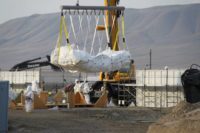Nuclear Waste Cleanup
BWXT-Amentum-Fluor Team Gains $45B DOE Hanford Cleanup Award

At its 580-sq-mile Hanford, Wash., nuclear waste cleanup site, the US Energy Dept. has picked a single contracting team to manage its large underground waste storage complex and a soon-to-start-up industrial plant to turn wastes into inert glass logs.
IMAGE: US Dept. of Energy
A team led by BWX Technologies Inc. has won a protested U.S. Energy Dept. megacontract at its Hanford former nuclear weapons site in Washington state that now combines major missions—which had been in separate contracts—to manage 56 million gallons of radioactive and chemical waste stored there and to operate a new plant that will begin to turn the material into glass for final disposal.
The award, worth up to $45 billion over 10 years, went to Hanford Tank Waste Operations and Closure LLC, a Lynchburg, Va., limited liability company that also includes units of Fluor Corp. and Amentum. Subcontractors to the team are DBD Inc., DSS Sustainable Solutions USA Inc., INTERA Inc., and Longenecker & Associates.
The winning team will operate the waste vitrification plant under construction since 2002, and now being commissioned by Bechtel National. It also will manage the storage of low-level radioactive and chemical wastes in 177 aging underground tanks and their eventual transfer to the estimated $17-billion treatment facility at the 580-sq-mile site. That work had been handled since 2008 by Washington River Protection Solutions, an Amentum-led company, with a 120-day transition period starting immediately. Amentum is a spin-off firm from AECOM created in early 2020.
Tank operations now are set to include single shell tank waste remediation and closure, and design, construction and operation of waste receiving facilities and pretreatment capabilities.
Vitrification plant startup originally was set for late this year but received a court-approved delay to 2025 due to the pandemic, with DOE officials saying the facility would operate next year following technical issues that arose in October 2022 as Bechtel began testing one of its giant waste melters.
DOE did not disclose names of bidders for the expanded contract, but there was one other competing team led by Atkins, a unit of Canada-base SNC Lavalin, and including Jacobs, Bechtel and Westinghouse, according to an industry source with knowledge of procurement details who declined to be identified. He told ENR that the teams "were essentially tied in scoring," but DOE likely chose the BWXT team based on “best value.”
The federal agency in December 2020 cancelled a $13-billion, 10-year contract awarded to a team led by BWXT Technical Services and Fluor Federal Services to manage the underground waste storage complex following bid protests by losing competitors Jacobs and Amentum.
Amentum, Fluor and Atkins also are key contractors for cleanup missions in other areas of the Hanford site.
The previous contract “no longer represents the most beneficial acquisition strategy for the Hanford mission,” an agency spokesman told ENR at the time. DOE said the government's "best interest" would be "to have a single contractor focused on integrated completion of the inter-related tank closure and direct feed low activity waste missions at Hanford.”
The new contract is an “end state” closure award, under which specific tasks will be negotiated for completion. Using the indefinite-delivery, indefinite quantity procurement approach, DOE negotiates specific tasks to be completed in either incentive fee or fixed-price awards.
The new contract includes requirements to subcontract 18% of work to small businesses and for local investment, including educational outreach and regional purchasing.
DOE did not respond to an ENR query as to how the combined contract expanded in value to the current level from an originally proposed $26 billion in early 2021, or how the new total splits between tank farm management and plant management.
Bechtel will continue construction, startup and commissioning of the vitrification plant, with the new contractor taking over once commissioning is complete.
Also under current negotiation with state and federal regulators are milestones after 2030 that are set for remediating high-level nuclear wastes at the site. Construction of treatment processes for those waste streams stalled several years ago due to problematic process technology.
The wastes are a legacy of plutonium production beginning at Hanford in World War II and ending in the 1980s for the U.S. nuclear weapons program. Hanford stopped operating in 1987.





